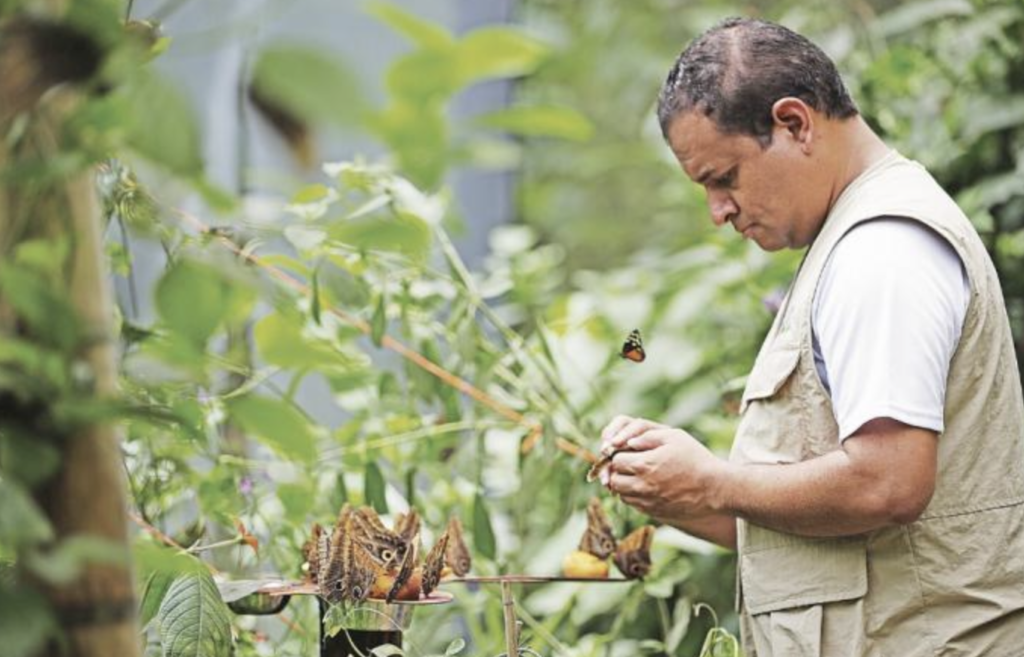
Panamanian Jaime Navarro left traditional livestock seven years ago to dedicate himself with suspicion to the “clocunate” butterfly breeding business, a sustainable model that is emerging in Panama thanks to foreign demand and its environmentally friendly system.
We did a lot of rehearsals in different lines such as livestock and agriculture, but when you went to the market you found yourself with a disadvantaged situation for the producer, because you lost time in producing and the sale was below what we expected,” he tells EFE Navarro, who dedicated about 10 years of his life to the field.
After a jaguar killed his cows in 2016, he immersed himself exports them to Turkey or offers them in the local market for events.
“( When Valdés proposed it) I thought ‘this guy is crazy’ because one in the field is subject to you selling the vaquita for an immediate result and you have an income. But the investment to raise a cow is quite high and its subsistence is worse,” explains Navarro, who has his farm near Penonomé, 170 km west of Panama City.
The “Mariposario Cerro La Vieja” project began in 2016 as the “largest” butterfly farm in Panama with “1,200 square meters of flight area with a tourist projection,” according to the biologist
“farm” of butterflies to export to that country that was building the largest butterfly farm in Europe.
There were no butterflies from Panama, there were from Costa Rica and other tropic countries. There was an interesting opportunity that we could exploit as a country, since we are a reference in terms of biodiversity,” says Valdés.
Panama, which according to popular legends means “abundance of fish and butterflies,” has approximately 1,600 types of “daytime” butterflies, not counting moths, although there is no official count, according to the biologist.
two main sources of sales.
We have barely completed a year since the new inauguration, but we hope that by the end of 2023 and mid-2024 we will reach about 4,000 monthly export pupae,” explains Valdés.
In the “farm” the life cycle of the butterfly is completed: from the moment it lays the egg until it reaches chrysalis or butterfly. Thus, you can export up to 500 golden chrysalises (pupas) to Turkey in a month or sell the butterflies for flight release at weddings in Panama, a booming fashion.
The chrysalis has a value between “50 cents and 1.50 dollar for export” and “in the local market you are buying between 25 cents and 1 dollar, depending on the species,
use of pesticides and insecticides and depending on biodiversity, the native plants of the area where you are and the butterflies that surround your home or your farm.”
The project is intrinsically conservation, it cannot be done otherwise,” says Valdés while explaining that the support of the business does not generate great economic demand since you do not have to feed butterflies, nor do they need large spaces, unlike livestock.
Butterfly producers
Valdés is looking for a network of butterfly “farmers” to increase production. Hand in hand with Navarro, he is encouraging farmers in the area to leave that activity and join this new ecobusiness model.
Thanks to the support of Cobre Panamá (a subsidiary of the Canadian First Quantum), Valdés is looking for “families interested in the production of butterflies, giving them training and material supplies, so that they can have a sustainable alternative for their family income.”
The biologist adds that by joining this idea, he gives the necessary tools such as the “malla” and the “training”. It also “guarantees the purchase (…) so that what we are going to buy can be produced.”
In addition, the former farmer adds that the production of butterflies has led him “to be as a support, inspiration and entrepreneurship for the family in improving the economy.”
Oooohhh butterflies. I wonder if an American Retiree would be accepted into the butterfly community? Moving to the Boquete area very soon. Does sound more enticing than raising cows, sheep, or goats.